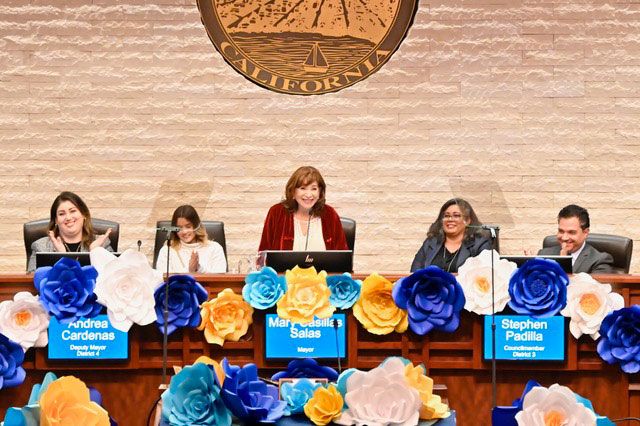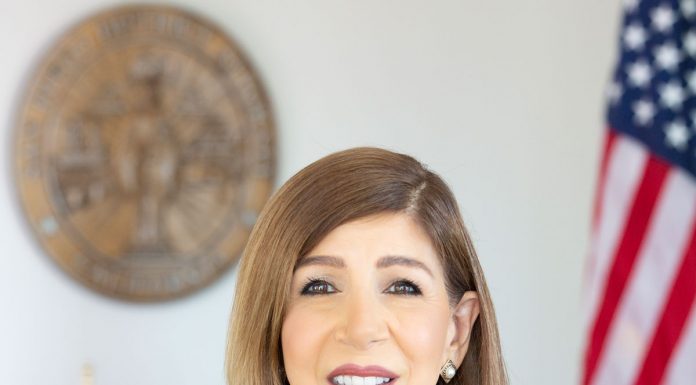
With a full house of dignitaries from Chula Vista present and past and its neighboring cities, Mayor Mary Casillas Salas gave her final 2022 State of the City address at City Hall on Nov. 29 after eight years of service as mayor to the second largest city in the county.
“This city has been my home for my entire life,” she said. “It has been home to my family for five generations. My family arrived here in 1919 and I have followed in their footsteps to serve our community and to make it right. Chula Vista, you have given me the greatest joy in my life…You also gave me a great opportunity eight years ago when you elected me to the best job ever. To serve as mayor to our great city.”
Salas said she looks back at the past eight years with “gratitude and wonder” saying that Chula Vista provided her family a “great place to thrive” and that she never imagined that one day, she would be mayor.
“It has been said that the essence of public service is to leave the people, places and things better than we found them through our work,” she said. “That has been the focus of my time here as mayor. To leave a better Chula Vista. Better for all of us who call this place home.”
Salas said when elected in 2014 as the first Latina mayor in the county, the city was still recovering from the Great Recession.
“We were able to restore our city’s financial health and we have consistently maintained a balanced budget and built heavy reserves,” she said.
Salas said part of the financial strategy was issuing bonds to pay off pension liability looming over future year budgets, reducing interest rates from 7% to 3% saving the city around $14 million every year.
Salas said together with the right community members and partners, they catalogued all the city’s infrastructure needs, then moved forward with Measure P, a temporary half cent sales tax in 2016, with the Measure generating more than $20 million annually dedicated to improving aging infrastructure.
“We have replaced two obsolete fire stations, and dozens of police and fire vehicles. We updated the police dispatch system, and repaired our senior center and recreation centers, including the complete renovation of the Loma Verde Center which is underway. We have replaced hundreds of miles of residential streets starting with those in the worse condition first. Then we launched our electric vehicle program to help reduce the use of fossil fuels.”
Salas said in 2018, when the city needed additional public safety services, working with key public safety officials, placed Measure A on the ballot, a one half cent sales tax, which generated more than $20 million a year dedicated to public safety personnel.
“In just four years, we have full staffing of our fire department, brought ambulance service support in-house, which has reduced response times and cut the cost of transport for our citizens by one-third. These funds allowed the city to hire 95 police officers and civilian support personnel. The city now has more sworn police officers in its history, and they are assisted by cutting edge technologies such as the drone program and a live 9-1-1. These actions have made Chula Vista a safer city.”
Salas said with work through city staff, the city has secured more than $50 million this year in state funding.
Salas said the city is now seeing the “vibrant revitalization and beautification” of downtown Third Avenue, Otay Ranch Center, and Millenia, and more. She said during and since the pandemic the city celebrated new businesses and restaurant openings which have “put Chula Vista on the map as a food, brew, pub, and entertainment destination in the South Bay.”
Salas said she is proud the city has advanced the development of the Chula Vista bayfront.
“It will be the centerpiece and catalyst of future projects on our Chula Vista bayfront,” she said. “This impressive $1.2 billion project is on the spectacular 585-acre bayfront location that was decades in the making. When opened in 2025, this will be Gaylord Hotels first west coast location. The resort is the largest construction project in California. This project will have significant impact on our local economy by creating thousands of construction jobs, and once opened, provide 4,000 direct, and indirect permanent jobs.”
Salas said the city never lost the vision to bring a four-year university to its University and Innovation District, with the state and San Diego State University, announced the first stage earlier this year of the city’s university development.
“We are going to build a 168 square foot cinematic arts academic center and library project,” she said. “It will be home to SDSU’s state of the art new television, film, and new media studios. And SDSU said this is only the beginning. The facility will have the first new library built since 1995. This location will advance the art of independent film making and will become the premiere academic location for aspiring filmmakers worldwide. It will also be available for use by Southwestern College and film industry partners. The $89 million project will be funded with $30 million in state funding and $59 million from the city of Chula Vista.”
Salas said the city was able to take over the operations of the Chula Vista Elite Athlete Training Center, training both local athletes and Olympic athletes from around the world, and other international sports competitions. “It is now one of the elite athlete training facilities in the world,” she said.
Salas said the Millenia project, a unique 210 acre mixed-use development featuring single homes, condominiums, apartments, office space, retail, hospitality, and mixed use projects, with six urban parks is now thriving.
Salas said the last three years and the COVID-19 pandemic has been the most challenging circumstances the city has ever faced.
“I have spoken of the troubles that we all have had,” she said. “We all shared those feelings of anxiety, and despair, and feeling overwhelmed. I know many of us lost dear family members, including several in my family. But we persevered and our community came together. And we could not have done it alone.”
Salas said with residents, nonprofits, assistance from the state, county, and federal partners, “we came out stronger as a city. The last three years have been the most challenging, but also the most rewarding.”
Starting March 13, 2020, she said the city declared the pandemic a public emergency, the first city in the county to do so, she said. Staff addressed the challenge by doing services and doing work far beyond their daily duties, she said.
• Librarians launched a call center to help residents find COVID testing sites, vaccines and other resources.
• Recreation staff delivered food packages to homebound residents.
• Firefighters made house calls when vaccines were available.
• Park rangers and staff kept parks accessible and handed out mask.
• Development services still got construction projects and home improvement permits approved.
• Police officers provided support for crowded food distributions.
• The finance counter was open every workday.
• Human resources developed policies so staff could work from home during the critical COVID months to keep the city running.
• Chula Vista’s animal care facility continued to support the hundreds of animals that come through its doors every year.
• The city started offering vaccines at City Hall and continue to do so.
• Opened up COVID testing, vaccines at the Chula Vista Center.
• Paramedics delivered thousands of shots to residents throughout the region.
“While so many things in our lives stopped, progress did not,” she said.
Salas said in the same spirit, the city, along with its partners began construction on the first shelter in South Bay for those in need.
“These prefabricated homes will provide needed shelter in a dignified manner, and a 24 hour staff that will provide resources and services to help our residents get back on their feet,” she said. “In that same spirit, we have made sure that our businesses have the tools that they need to survive the pandemic and thrive in our local economy.”
Salas said Chula Vista Cares grant program awarded approximately $1.3 million in grants to 279 businesses and soon will award an additional $3.6 million through partnership with the San Diego Foundation.
“As we all know, our small businesses are critical to ensure the economic growth and prosperity that our city needs,” she said.
Salas said passing Measure Q for cannabis sales in the city, which is already providing millions in revenue to the city and adopted strategies to shut down illegal pot shops that had plagued the city for so long.
“While economic development and increased revenue is critical, our city is not complete without arts and culture,” she said. “This year we began work on the first cultural arts space in Chula Vista. This accomplishment was made more special when my city council named the new art space Casa Casillas, after my mother Paula Casillas who is 99 years old. I am so grateful, and my mother is truly honored. By the way she is a terrific artist.”
Salas said she was extremely happy to see the cultural, civic, and entertainment events come back after the pandemic, noting more than 20,000 people came to Third Avenue for the Chula Vista Block Party.
“These efforts have revived our civic pride,” she said. “It reaffirmed the strength in our community, ourselves, and in the uniqueness that makes us Chula Vista. There is truly strength in our diversity, and I am proud that Chula Vista became the first city in the state of California to be certified as a Welcoming City because of our commitment to our immigrant communities. We deeply value the innovation, the creativity, and the hard work that our immigrants bring to our city, our state, and our nation. We want to ensure that future generations enjoy what we sometimes take for granted—our climate and our environment.”














